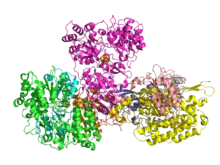NADH:ubiquinone reductase (non-electrogenic)
NADH:ubiquinone reductase (non-electrogenic) (EC 1.6.5.9, NDH-2, ubiquinone reductase, coenzyme Q reductase, dihydronicotinamide adenine dinucleotide-coenzyme Q reductase, DPNH-coenzyme Q reductase, DPNH-ubiquinone reductase, NADH-coenzyme Q oxidoreductase, NADH-coenzyme Q reductase, NADH-CoQ oxidoreductase, NADH-CoQ reductase) is an enzyme with systematic name NADH:ubiquinone oxidoreductase.[2][3][4][5] This enzyme catalyses the following chemical reaction:
- NADH + H+ + a quinone NAD+ + a quinol
| NADH:ubiquinone reductase (non-electrogenic) | |||||||||
|---|---|---|---|---|---|---|---|---|---|
 | |||||||||
| Identifiers | |||||||||
| EC no. | 1.6.5.9 | ||||||||
| CAS no. | 9028-04-0 | ||||||||
| Databases | |||||||||
| IntEnz | IntEnz view | ||||||||
| BRENDA | BRENDA entry | ||||||||
| ExPASy | NiceZyme view | ||||||||
| KEGG | KEGG entry | ||||||||
| MetaCyc | metabolic pathway | ||||||||
| PRIAM | profile | ||||||||
| PDB structures | RCSB PDB PDBe PDBsum | ||||||||
| Gene Ontology | AmiGO / QuickGO | ||||||||
| |||||||||
The 3 substrates of this enzyme are NADH, H+, and a quinone (electron acceptor), whereas its two products are NAD+ and a quinol (reduced acceptor).
An important example of this reaction is:
- NADH + H+ + ubiquinone NAD+ + ubiquinol
This enzyme is a flavoprotein (FAD). It belongs to the family of oxidoreductases, specifically those acting on NADH or NADPH with other acceptors. The systematic name of this enzyme class is NADH:(quinone-acceptor) oxidoreductase. Other names in common use include reduced nicotinamide adenine dinucleotide (quinone) dehydrogenase, NADH-quinone oxidoreductase, NADH ubiquinone oxidoreductase, DPNH-menadione reductase, D-diaphorase, and NADH2 dehydrogenase (quinone), and mitochondrial (mt) complex I. This enzyme participates in oxidative phosphorylation. Several compounds are known to inhibit this enzyme, including AMP, and 2,4-dinitrophenol. NADH dehydrogenase is involved in the first step of the electron transport chain of oxidative phosphorylation (OXPHOS). Any change in the electron transport component caused by a mutation might effect the normal electron flow. This might be leading "an increase of bifurcation and generation of superoxidase radicals and increase oxidative stress in various types of cancer cells."[6]
In the electron transport chain NADH is mainly used to create a concentration gradient of hydrogen in order to make ATP. Since After NADH is oxidized a hydrogen is pumped out and NAD+ will be a product.[7]
Structural studies
Several structures are available of this enzyme, which is part of the respiratory chain. It is a multi-subunit enzyme in which this activity is located in the hydrophilic domain. The subunits of the membrane-embedded domain are responsible for proton translocation.
References
- Berrisford JM, Sazanov LA (2009). "Structural basis for the mechanism of respiratory complex I". J Biol Chem. 284 (43): 29773–83. doi:10.1074/jbc.M109.032144. PMC 2785608. PMID 19635800.
- Moller, I.M; Palmer, J.M. (1982). "Direct evidence for the presence of a rotenone-resistant NADH dehydrogenase on the inner surface of plant mitochondria". Physiologia Plantarum. 54: 267–274. doi:10.1111/j.1399-3054.1982.tb00258.x.
- de Vries S, Grivell LA (September 1988). "Purification and characterization of a rotenone-insensitive NADH:Q6 oxidoreductase from mitochondria of Saccharomyces cerevisiae". European Journal of Biochemistry. 176 (2): 377–84. doi:10.1111/j.1432-1033.1988.tb14292.x. PMID 3138118.
- Kerscher SJ, Okun JG, Brandt U (July 1999). "A single external enzyme confers alternative NADH:ubiquinone oxidoreductase activity in Yarrowia lipolytica". Journal of Cell Science. 112 ( Pt 14) (14): 2347–54. PMID 10381390.
- Rasmusson AG, Soole KL, Elthon TE (2004). "Alternative NAD(P)H dehydrogenases of plant mitochondria". Annual Review of Plant Biology. 55: 23–39. doi:10.1146/annurev.arplant.55.031903.141720. PMID 15725055.
- Yusnita, Yakob; Norsiah, Md Desa; Rahman, A. Jamal (2010-12-01). "Mutations in mitochondrial NADH dehydrogenase subunit 1 (mtND1) gene in colorectal carcinoma". The Malaysian Journal of Pathology. 32 (2): 103–110. ISSN 0126-8635. PMID 21329181.
- Alberts, Bruce; Johnson, Alexander; Lewis, Julian; Raff, Martin; Roberts, Keith; Walter, Peter (2002-01-01). "Electron-Transport Chains and Their Proton Pumps".
{{cite journal}}: Cite journal requires|journal=(help)
Further reading
- Koli AK, Yearby C, Scott W, Donaldson KO (1969). "Purification and properties of three separate menadione reductases from hog liver". J. Biol. Chem. 244 (4): 621–9. doi:10.1016/S0021-9258(18)94400-5. PMID 4388793.
External links
- NADH:ubiquinone+reductase+(non-electrogenic) at the U.S. National Library of Medicine Medical Subject Headings (MeSH)